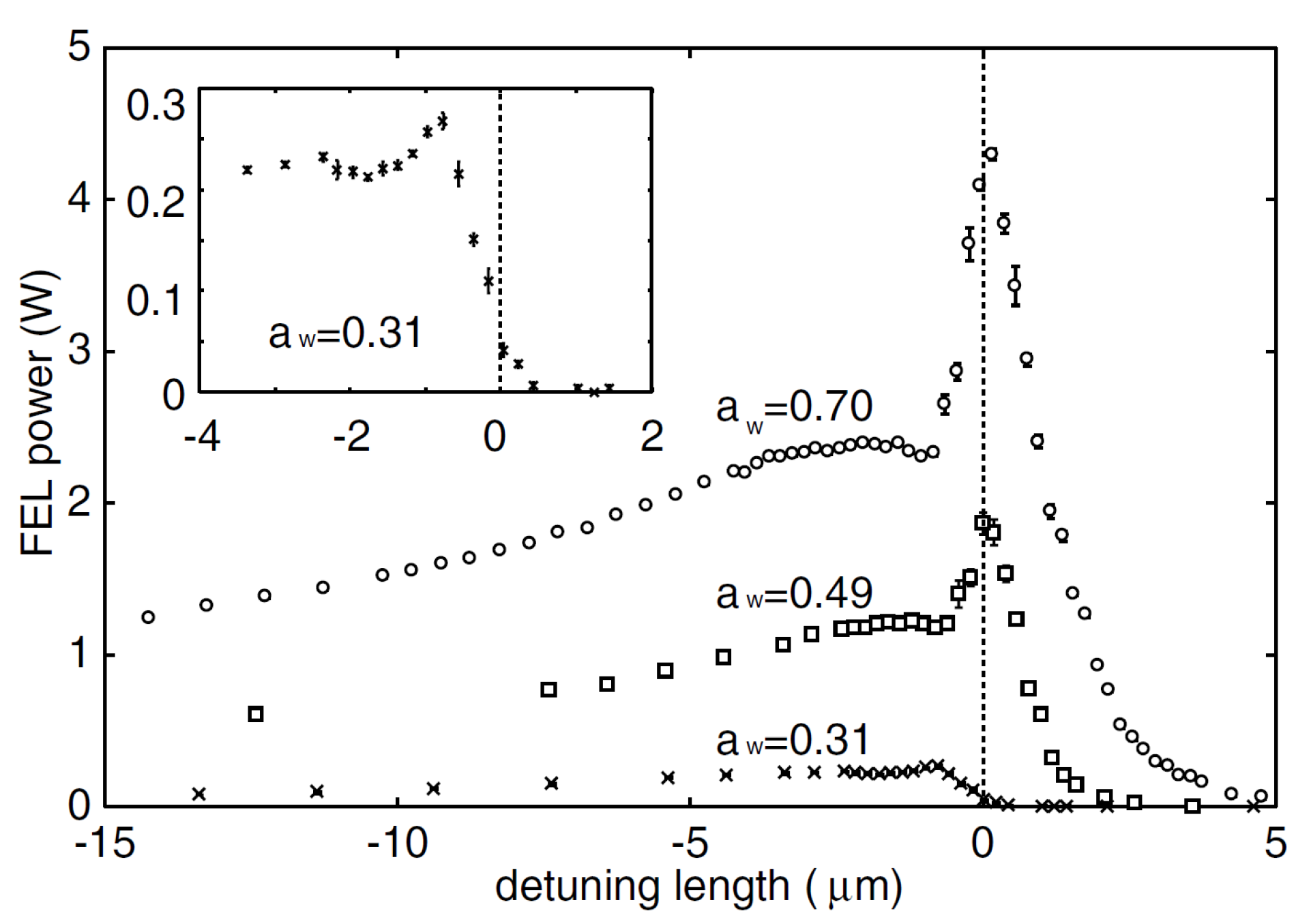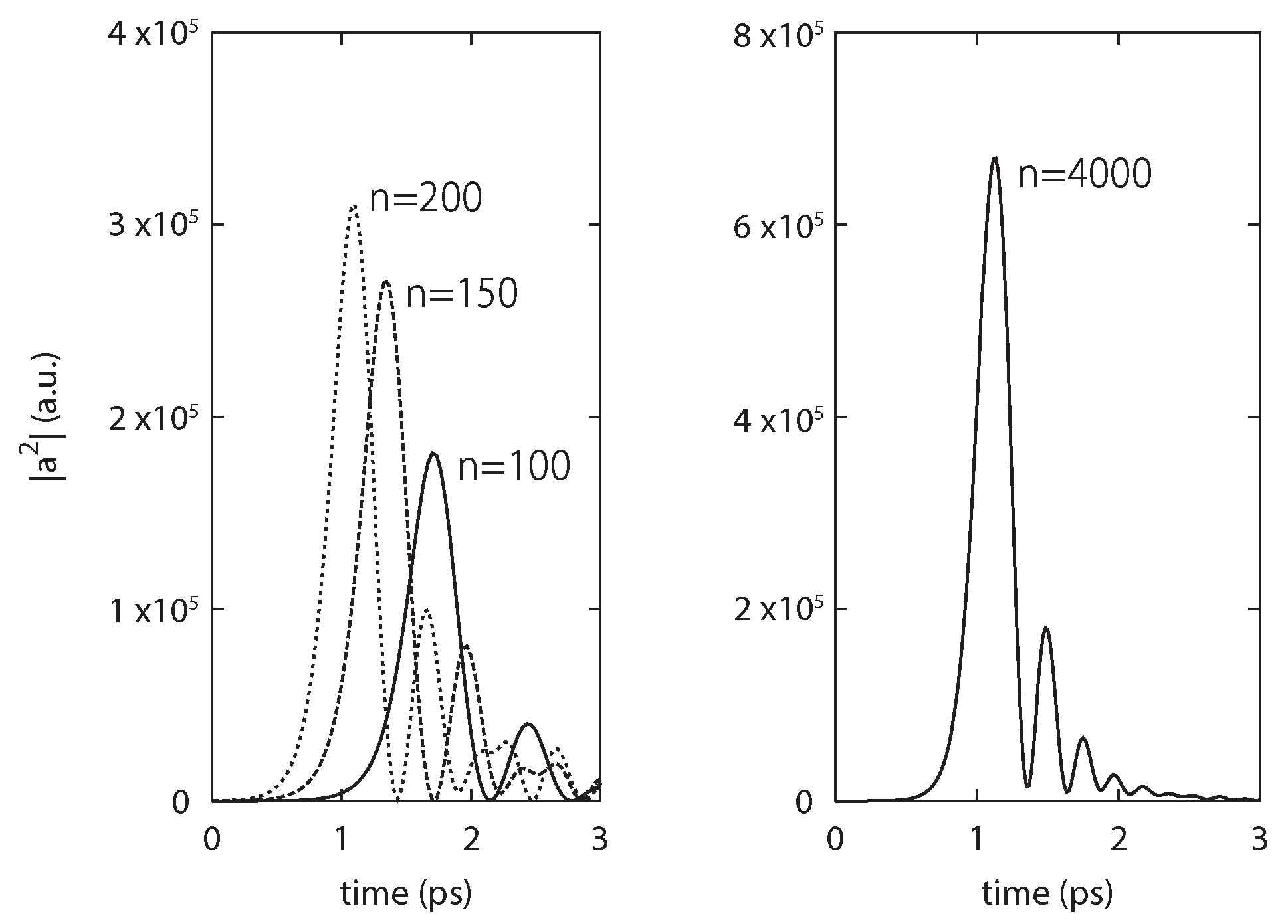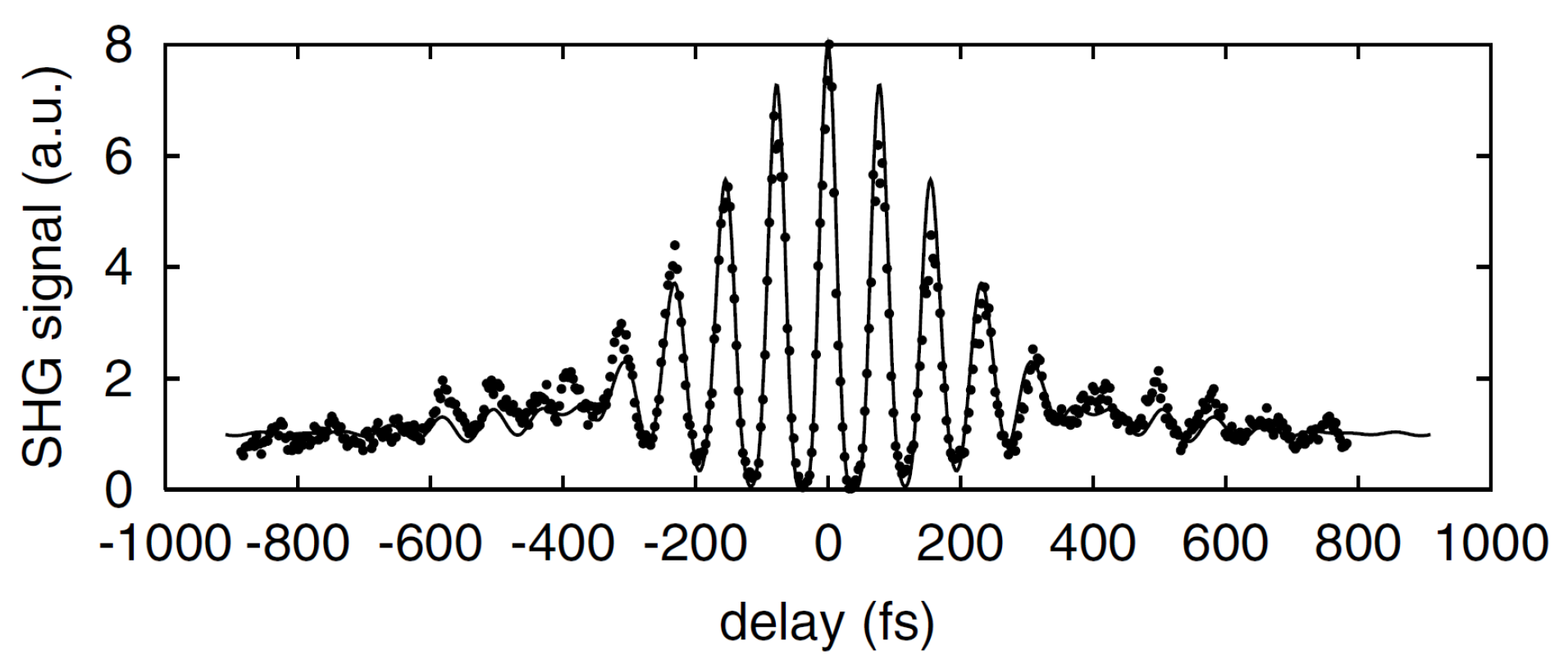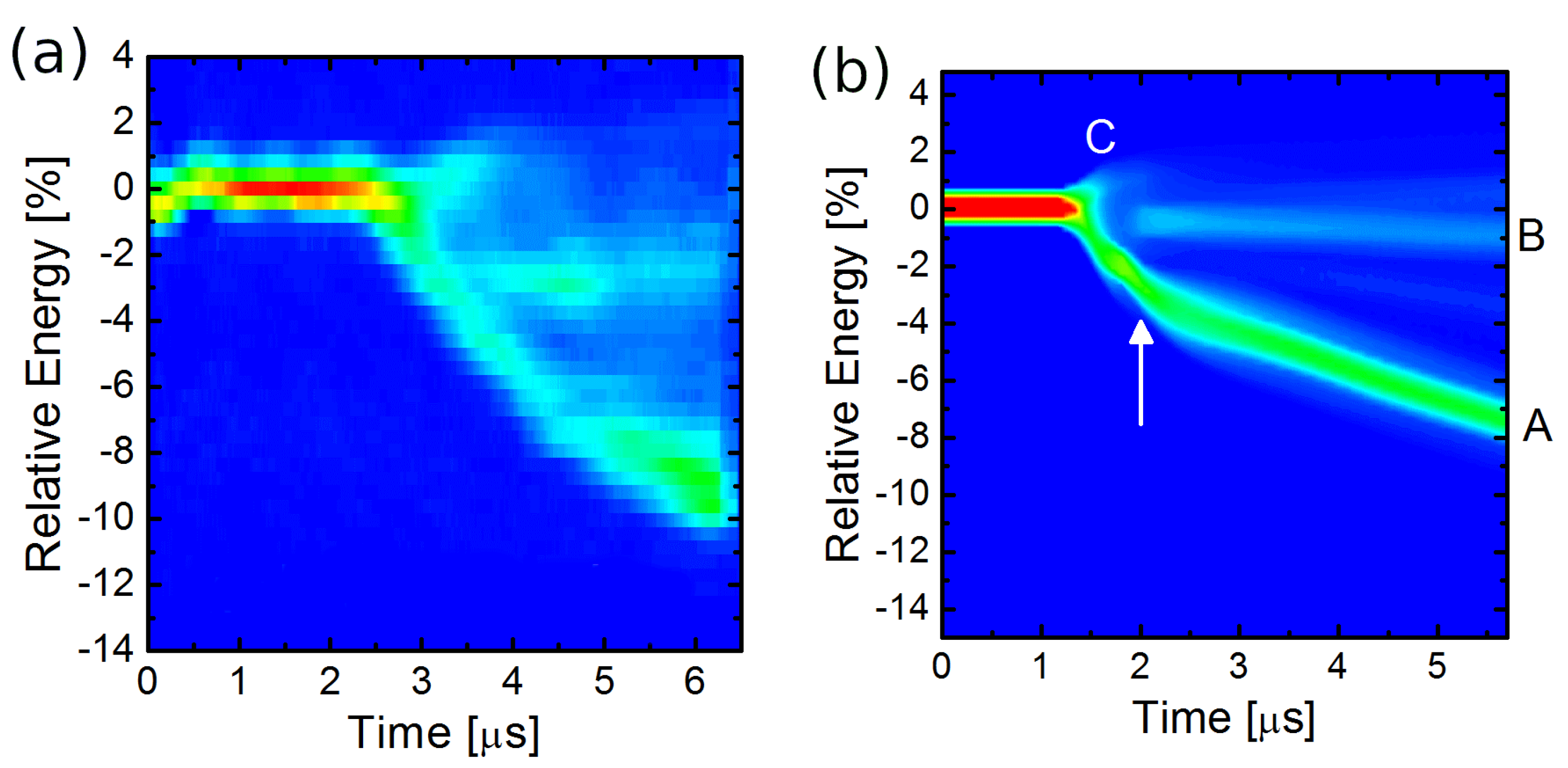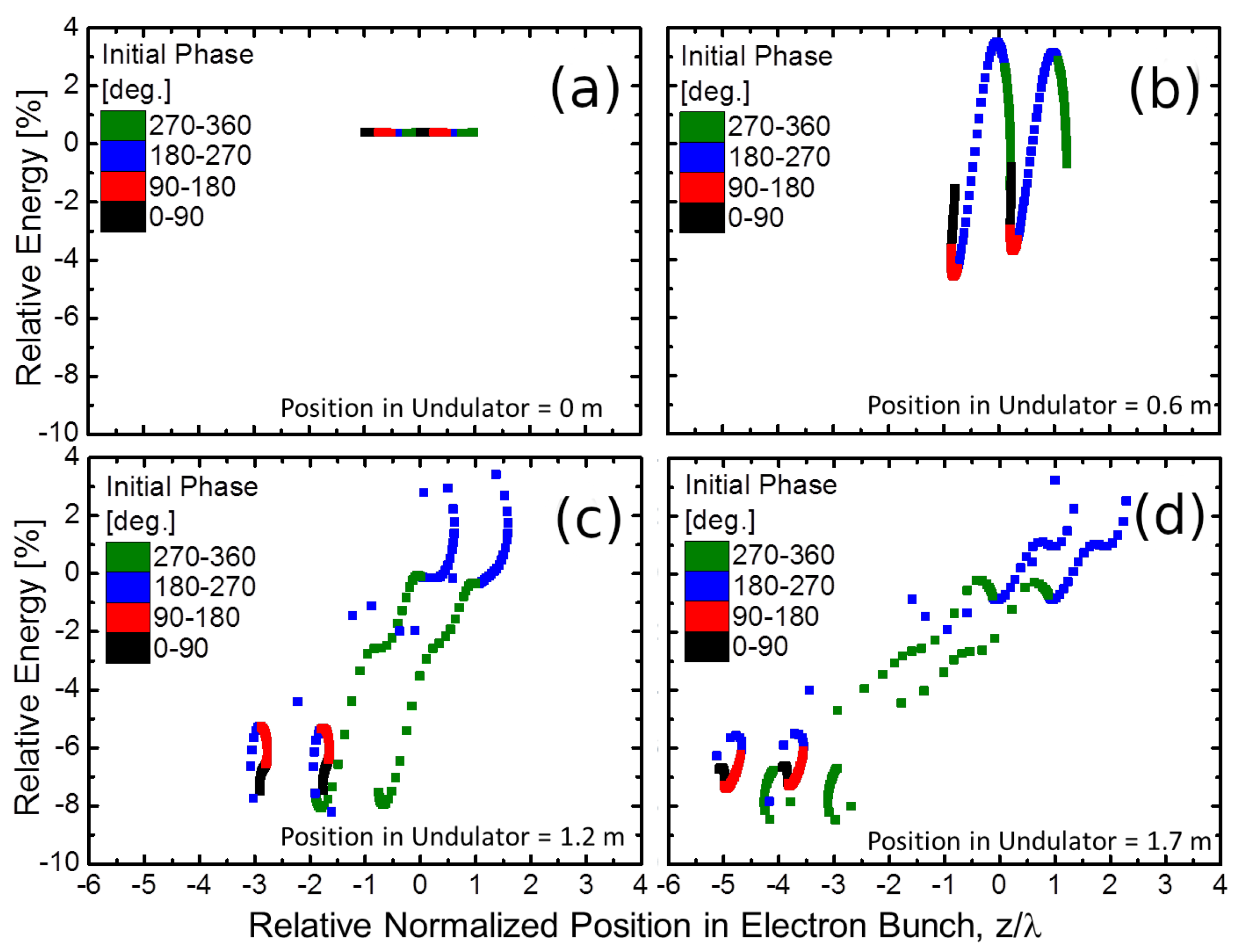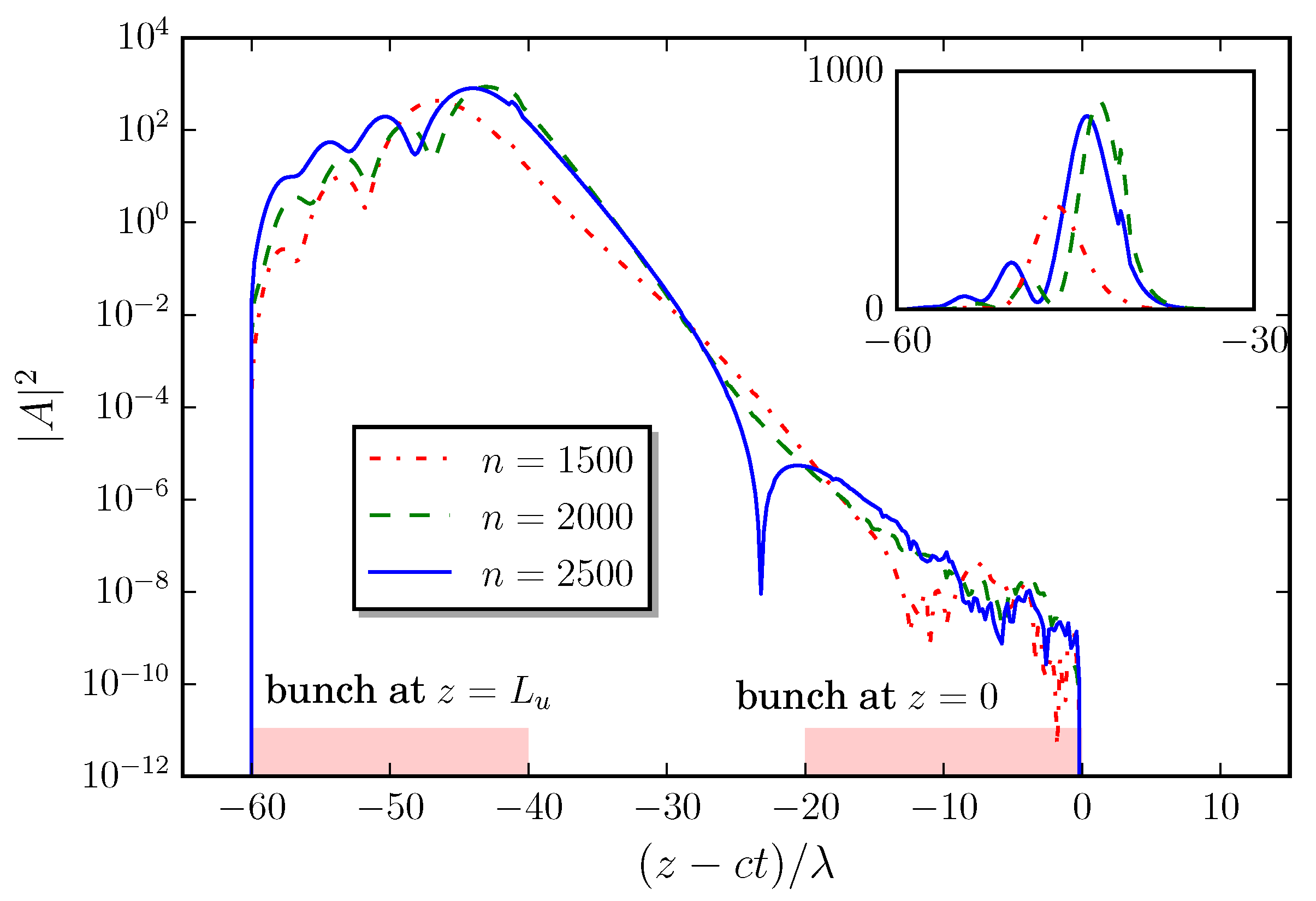1. Introduction
Bonifacio and his colleagues first suggested that free-electron laser (FEL) may be operated in the superradiant regime, in which the radiated peak power is proportional to the squared electron number,
, from self-bunched systems [
1]. The radiation intensities scaling as the squared emitters number is similar to superradiance at two-level systems as defined by Dicke [
2]. Superradiance of a single electron bunch or a periodically bunched beam may occur in any kind of free-electron radiation emission scheme including synchrotron radiation, undulator radiation, and FEL [
3]. In the superradiance FEL, a periodical bunching structure is self-organized in the electron beam traversing an undulator and the bunched beam emits cooperative radiation. Superradiance appears in both single-pass FEL amplifiers and multi-pass FEL oscillators when the FEL is operated at an appropriate condition.
The lasing behavior of FEL can be classified in terms of the characteristic lengths: , , and . The first parameter, , is the bunch length. In FELs driven by RF linear accelerators, the bunch length is typically 0.1–1 mm (0.3–3 ps). The slippage length, , is the product of the radiation wavelength, , and the number of undulator periods, . The last parameter, , the cooperation length, is a function of the radiation wavelength, , and the fundamental FEL parameter, , as , which is equal to the slippage length in an exponential gain length.
Superradiance in FEL amplifiers is classified into weak and strong superradiance according to the relationship between the characteristic lengths [
4]. The weak superradiance occurs when an FEL is operated in the high-gain and strong-slippage regime,
. The electron bunch is self-bunched due to the FEL interaction and the self-bunched electrons emit cooperative radiation in the slippage region. The intensity of the radiation at the slippage region scales as
. Bonifacio called the radiation weak superradiance because the intensity at the slippage region is smaller than that of the steady-state high-gain FEL lasing, where the slippage is negligible. Strong superradiance appears in a long-pulse high-gain FEL amplifier,
and
. In this case, the trailing region of the FEL pulse exhibits a spiking behavior as a result of the emission of self-bunched electrons in the slippage region. The intensities at the slippage region are much larger than that of the steady-state FEL lasing.
Superradiance is also observed in short-pulse FEL oscillators, where a periodical bunching structure is self-organized after the recursive interaction of the electron bunches and the optical pulse to emit cooperative radiation in the slippage region. In the present paper, we review historical remarks of superradiance FEL experiments in short-pulse FEL oscillators with emphasis on few-cycle pulse generation and discuss the application of few-cycle FEL pulses to attosecond ultraviolet and X-ray pulses via high-harmonic generation from gas and solid targets.
Superradiance in short-pulse FEL oscillators exhibits unique features: (i) high extraction efficiency; (ii) isolated (or solitary) few-cycle pulse; (iii) the lasing maintained by shot noise; and (iv) possible carrier-envelope phase stabilization by an external seed laser. In the following sections, we see experimental results of superradiance in FEL oscillators and outline the above unique features. Then, we discuss possible applications of such few-cycle pulses to high-harmonic generation for attosecond ultraviolet and X-ray pulses, that is FEL-HHG. Finally, the research program established for developing basic technologies and conducting a proof-of-principle experiment for the FEL-HHG is presented.
3. Scaling Law of the Superradiance in FEL Oscillators
In the superradiance at two-level systems, the number of emitted photons (
) and the pulse duration (
) scale as the number of two-level emitters (
N):
and
. Analytical studies revealed that the same superradiance scaling appears in FEL oscillators operated at small negative detuning length [
7,
8] and perfectly synchronized cavity length [
17].
In short-pulse FEL oscillators operated at small negative detuning length, it was analytically derived that the peak power,
, efficiency,
, and the number of optical cycles,
, follow the scaling law given by a function of the fundamental FEL parameter,
, bunch length,
, cooperation length,
, and round-trip loss of the optical cavity,
: [
7]
and the maximum efficiency occurs approximately for the cavity length shortening
. The above scaling law is valid for an FEL oscillator driven by an electron bunch shorter than the slippage length, where the lasing behavior can be described by eigenmode (supermode) analysis. The scaling law was experimentally confirmed at the FEL oscillator, FELIX, in which the peak power, extraction efficiency, pulse energy were measured with changing the bunch charge [
9].
For the further discussion in the present paper, we convert the fundamental FEL parameter
into the Colson’s dimensionless current
, which is commonly used for analyzing small-gain FEL oscillators [
28]. Following the relation
, we can rewrite Equation (
2) as
The left-hand side,
, is the extraction efficiency normalized by the number of undulator periods. The dimensionless current,
, is proportional to the peak current and the above equation is valid for a square-shaped bunch with a constant peak current. For an electron bunch with an arbitrary temporal profile, the above equation should read
Since the dimensionless current is proportional to the beam current , we can again confirm the efficiency scales to the number of electrons as .
In the JAERI-FEL experiment, we observed an FEL efficiency exceeding the above scaling law of superradiant FEL oscillator [
29]. This is because high efficiency lasing obtained at the perfect synchronization of the optical cavity cannot be covered by the supermode analysis.
As we can see from the simulation result in
Figure 4, an isolated pulse evolves in an FEL oscillator operated at the perfect synchronization. Generation of such isolated pulse in superradiant FEL oscillators was discussed in a previous paper to derive a set of equations, which have the approximate solution of a hyperbolic secant pulse [
30]. In the study, however, a handy scaling formula of the FEL efficiency for arbitrary experimental parameters was not explicitly given. Thus, we conducted a series of numerical simulations to obtain the scaling of the FEL efficiency for arbitrary FEL operation parameters.
The simulations were carried out by a one-dimensional time-dependent FEL code same as our previous study [
14]. We chose the number of undulator periods at
, and the bunch length normalized to the slippage length at
, and varied the normalized cavity loss,
, in the range of
.
Figure 8 plots the simulation results of the normalized FEL efficiency at the perfectly synchronized cavity length,
, as a function of
, the inverse square root of the normalized cavity loss. In the simulations, a rectangular-shaped bunch was assumed and the shot noise was introduced according to the standard algorithm [
31]. The results of the JAERI experiment are also plotted.
We can confirm from the simulation results that the FEL efficiency at the perfectly synchronized cavity length is given by a function of a single variable
, the normalized cavity loss. The simulation results also suggest that there is a threshold,
, for the lasing at
. The threshold for the evolution of a hyperbolic secant pulse and the extraction efficiency in superradiance FEL are analytically discussed in previous papers [
17,
30]. Derivation of a mathematical expression to fit the simulation results and comparison with the analytical studies remain future works.
4. Role of Shot Noise
In FEL oscillators, as in single-pass SASE-FELs, the evolution of optical pulse starts from shot noise resulting from the random distribution of electrons in the bunch. In general, the shot noise has little effect on the FEL lasing after the onset of saturation because the intensity of the shot noise within the FEL bandwidth is negligibly small. In
Section 2.2, we note that the role of shot noise in FEL oscillators with the perfectly synchronized cavity is different from the normal FEL lasing. The shot noise plays an intrinsic role in maintaining the FEL lasing at
even after the onset of saturation.
In a short pulse FEL oscillator, the trailing part of the optical pulse is amplified as a result of coherent emission from the electron bunch at the slippage region. With a negative cavity-detuning length, the amplified part is pushed forward to the leading edge of the pulse. This intra-pulse feedback of the optical field is the source of the exponential growth of an optical pulse in FEL oscillators.
In FEL oscillators with the perfectly synchronized cavity, there is no intra-pulse feedback and the pulse evolution obeys linear growth instead of exponential growth [
17]. The leading part of the optical pulse at the
lasing contains incoherent shot noise with random amplitude and phase even after the onset of saturation. The amplitude and phase in the entire FEL pulse are governed by the interaction between the electrons and the radiation initiated by the shot noise in the leading part. As a result of random shot noise, the FEL pulse intensity exhibits slowly evolving fluctuation during a macropulse, as shown in
Figure 3. We see, in the next section, that the shot noise introduces fluctuation in the carrier frequency and phase of an optical pulse evolving in an FEL oscillator operated at
.
The role of shot noise at the
lasing can be confirmed by a numerical simulation. We conducted two simulations with parameters for the JAERI-FEL experiment: one with shot noise determined by the standard formula [
31] and the other with shot noise
of that. Detuning curves for two cases are plotted in
Figure 9, in which we can see that the simulation with the standard shot noise gives FEL lasing with large extraction efficiency around zero-detuning length, but FEL lasing does not occur with a detuning range of
for the smaller shot noise.
5. Stabilization of Carrier-Envelope Phase
Generation of a few-cycle laser pulse and its application for studying ultrafast physics in laser–matter interaction is one of the topical research subjects in advanced laser science [
32,
33,
34,
35]. In laser-matter interaction at the strong field regime, the laser oscillating electric field sways electrons of a target atom and causes tunneling ionization when the laser intensity is comparable with the atomic nucleus potential. The laser–matter interaction in the strong field regime must be studied in terms of the oscillating electric field rather than the instantaneous intensity. Carrier-envelope phase (CEP) is, therefore, important for characterizing a few-cycle laser pulse for the strong-field regime. Carrier-envelope phase of a laser pulse is also indispensable for the application of a mode-locked laser to optical frequency combs, in which the pulse-to-pulse carrier-envelope offset is stabilized for a broadband optical frequency comb to determine all line frequencies [
36]. In solid-state lasers, stabilization and control of the CEP of few-cycle laser pulses can be realized with either passive or active manner [
33,
37]. As discussed in the previous sections, a short-pulse FEL oscillator operated at the perfectly synchronized cavity length can generate an isolated few-cycle FEL pulse, which can be utilized for exploring ultrafast science. Since FEL oscillators have unique features of wavelength tunability and high-repetition-rate availability, FEL will be an attractive photon source complimentary to solid-state femtosecond lasers.
Such few-cycle pulses from FEL oscillators would be more attractive, if the carrier-envelope phase of the pulse were stabilized. However, CEP stabilization in FEL oscillators has never been demonstrated because the evolution of FEL pulses is initiated by the uncontrollable shot noise. In the few-cycle lasing at the perfectly synchronized cavity, the leading part of the optical pulse contains incoherent shot noise with random amplitude and phase. The amplitude and phase in the entire FEL pulse are governed by the interaction between the electrons and the radiation initiated by the shot noise in the leading part. Consequently, the carrier frequency and phase of the FEL pulses are not stabilized.
A numerical simulation suggested possible stabilization of a few-cycle superradiant FEL pulse by utilizing Michelson resonator, but the stabilization of CEP was not discussed [
38]. Another method was proposed for full stabilization of carrier-envelope phase of the few-cycle FEL pulse generated in an FEL oscillator [
39]. The method is based on a CEP-stable external seed laser to fix the phase and amplitude of the leading part of the FEL pulse.
Simulation results to demonstrate the CEP stabilization are presented in
Figure 10 and
Figure 11. The simulation parameters are listed in
Table 1, in which the parameters for the JAERI experiments are shown for comparison.
Figure 10 shows the temporal profiles of FEL pulses after 1500, 2000, and 2500 round trips in a perfectly synchronized FEL oscillator. In this plot, the longitudinal coordinate is defined such that the leading edge of the electron bunch is located at the undulator entrance,
, at the reference time,
. The pulse intensity is expressed as a dimensionless value normalized by the high-gain FEL parameter
such that
determines the ratio between the energy densities of the FEL radiation and the resonant electron beam [
4]. The position and profile of the electron bunch at the entrance and exit of the undulator are also depicted to demonstrate that the FEL lasing is in the strong-slippage regime.
Figure 10 illustrates the characteristics of FEL pulses evolving in a high-gain and strong-slippage FEL oscillator with a perfectly synchronized optical cavity. The optical pulse consists of an exponential lobe of the leading edge and the main peak followed by ringing. The duration of the main peak, 4.4 cycles (FWHM) after 2500 round trips, is much shorter than that of the electron bunch. The pulse height and peak position are not fixed and exhibit continuous variation along with the pulse energy changes. The main peak followed by ringing is common to superradiance observed in two-level systems [
15] and identical to previous results for the analysis of a high-gain FEL amplifier [
4] and a perfectly synchronized FEL oscillator in the transient regime [
17], both of which indicated the FEL lasing to be superradiance. The electron bunch slips backward inside the optical pulse during the motion in the undulator. In this motion, the electron bunch forms microbunch through interaction with the optical field and then emits strong radiation in the slippage region. The emission in the slippage region is accompanied by frequency down chirp to keep emission along electron energy decreasing [
14]. This down chirp contributes to a large FEL conversion efficiency, but introduces a large energy spread in the spent electron beam as well. In a conventional FEL oscillator, the optical cavity length is shortened so that the optical pulse is pushed forward every round trip to enlarge a single-pass gain by introducing strong electron bunching with a high-intensity optical field at an early section of the undulator. The cavity-length shortening achieves feedback of radiation power from the tail to the head of optical pulse, which also communicate optical phase and frequency from the tail to the head. As a result, the cavity length shortening constrains phase correlation inside the optical pulse, which prohibits the strong down chirp observed in the lasing at the perfectly synchronized cavity.
The logarithmic plot of the FEL pulse in
Figure 10 shows that the dynamic range of laser pulse intensity from the leading edge to the peak is greater than
. The leading part of the optical pulse contains incoherent shot noise with random amplitude and phase. The amplitude and phase of the field in the exponential envelope, the main peak and the ringing are all governed by the interaction between the electrons and the radiation initiated by the shot noise in the leading part. Consequently, the carrier frequency and phase of the FEL pulses are not stabilized and vary over round trips.
Figure 11 shows FEL pulses obtained in a simulated FEL oscillator with injection seeding, where all the parameters are the same as in
Figure 10. The seed laser pulse is assumed to have the resonant wavelength, an intra-cavity intensity of
, and temporal duration of
with stable CEP. The seed pulse timing is chosen such that a half of the seed pulse overlaps with the FEL pulse and the rest is out of the FEL pulse to indicate the seed laser intensity not affected by the FEL interaction. In
Figure 11, we can see that the seed laser efficiently stabilizes the FEL oscillator with a perfectly synchronized cavity. The FEL pulse after the saturation retains an almost identical temporal shape: the main pulse of 3.8 cycles (FWHM) followed by periodic ringing. The small fluctuations observed in the ringing are attributed to the effect of shot noise, whose intensity is three orders of magnitude smaller than that of the seed pulse.
The effects of the CEP stabilization can be clearly confirmed in
Figure 12, which shows instantaneous intensity and phase of FEL pulses evolving in the perfectly synchronized cavity for the two cases without and with a seed laser. The instantaneous phase,
, is defined such that the complex field is expressed as
, where
is the FEL resonance frequency. The simulation parameters are the same as
Figure 10 and
Figure 11, respectively. A few-cycle FEL pulse is established after a start-up period, ∼500 round trips. In the few-cycle FEL pulse, the carrier phase is continuous whole through the pulse except for the leading edge. Since the pulse leading edge is a free boundary governed by shot noise, the pulse always suffers from fluctuation introduced by the shot noise. As a result, the pulse has a chance to lose the memory of the original carrier phase or to be replaced by another pulse. These variations of FEL pulse occur in the time scale of the FEL pulse evolution from the shot noise to the saturation, ∼500 round trips in the case. In the lasing without a seed laser, the phase of the leading part has fluctuation due to the shot noise, which makes pulse shape and CEP unstable over many round trips. The FEL pulse evolution with an external seed laser exhibits a quite different aspect, in which the pulse shape and CEP after the onset of saturation are stabilized. The nonlinear phase advance from the head to the tail of pulses in
Figure 12a,b corresponds to the frequency down chirp [
14].
6. Proposal of FEL-HHG
High-harmonic generation (HHG) is a nonlinear process to realize the emission of the high harmonics of the incident beam from a target illuminated by an intense laser pulse. Recent development of solid-state laser technologies has realized a generation of isolated attosecond pulses in ultraviolet and X-ray wavelengths via HHG in gas and solid-state targets [
32,
34,
40]. As such attosecond photon sources are routinely available in laboratories, attosecond science is becoming an active research field, in which ultrafast dynamics in atoms and molecules is investigated in detail. In addition, the HHG is an interesting research subject as an interaction of strong laser field with atoms and molecules.
Combination of HHG and an FEL was first examined at a SASE FEL, where an ultraviolet pulse from HHG was used as a seed laser to stabilize the shot-to-shot variation in spectrum and energy of the SASE-FEL pulses [
41]. The experiment can be called HHG-seeded FEL or HHG-FEL. To the contrary, an optical pulse generated from an infrared FEL can be used, in principle, to drive HHG, that is FEL-HHG [
42].
There are several trends in the development of HHG photon sources. One of the major trends is increasing the photon energy (or decreasing the photon wavelength) available in HHG photon sources. The highest photon energy so far demonstrated is a generation of a bright supercontinuum that spans from the ultraviolet to more than 1.6 keV [
43]. The experiment adopted a mid-infrared laser pulse at a wavelength of
λ = 3.9 μm as a driver of HHG. Theoretical and experimental studies revealed that the HHG cut-off energy scales as
in the phase-matched condition [
43,
44]. The scaling law implies possible extension of the HHG photon energy beyond 1.6 keV by utilizing a mid-infrared laser pulse,
m. However, pushing the cut-off energy above 1.6 keV has not been realized mainly due to the lack of mid-infrared laser pulses satisfying conditions for HHG, wavelength, pulse energy, pulse duration, and repetition. Thanks to the wavelength tunability and the high-repetition-rate availability, an FEL oscillator is a potential driver of HHG photon sources complementary to conventional solid-state femtosecond lasers.
We proposed a concept of FEL-HHG based on superradiant FEL at a perfectly synchronized FEL oscillator.
Figure 13 shows a schematic view of the proposed FEL-HHG. The FEL wavelength should be determined from the requirements of attosecond pulse generation in HHG. For a generation of attosecond pulses whose wavelength covers from ultraviolet to X-ray above 1 keV, we assume the FEL wavelength of 2–6
m from the scaling law of HHG cut-off energy. A superconducting linac is adopted to deliver a CW pulse train to the FEL-HHG.
Example sets of FEL-HHG parameters are listed in
Table 2, where the FEL wavelength is 2–6
m and the parameters are chosen so that FEL pulse energy is 0.5 mJ. We consider such FEL oscillators can be constructed with existing technologies: a photo-cathode electron gun [
45] and superconducting RF cavities [
46].
7. Research Program for FEL-HHG
A 10-year research program (2018–2027) has been funded to develop basic technologies for the FEL-HHG [
47]. In the program, we are conducting research and development towards the FEL-HHG at two FEL facilities, KU-FEL at Kyoto University and LEBRA-FEL at Nihon University, both of which are infrared FEL oscillators driven by normal conducting linear accelerators. These facilities of infrared FELs can be exploited for basic technologies development and a following proof-of-concept experiment of FEL-HHG, whereas FEL-HHG for a full-scale application of attosecond ultraviolet and X-ray pulses should be realized by a superconducting linac FEL oscillator.
The research subjects to be conducted are: (1) generation and characterization of few-cycle mid-infrared pulses from the FEL oscillators; (2) enhancement of FEL pulse energy by an external optical cavity; and (3) scheme for CEP stabilization of FEL pulses including the development of a mid-infrared seed laser. We plan to explore these subjects in the first six years, 2018–2023, and proceed to a proof-of-concept experiment of the FEL-HHG at two facilities.
In the following sections, we describe the plan and the current status of our research program.
7.1. Pursuing the Ultimate Extraction Efficiency
As described in
Section 2.3, the FEL lasing of 5.5% extraction efficiency was realized in KU-FEL with 25–55-pC electron bunches from the 4.5-cell RF gun operated at the thermionic emission mode [
26]. After the upgrade of the gun drive laser system, we demonstrated the FEL extraction efficiency of 9.4% with 190-pC electron bunches generated by the same RF gun operated at the photoemission mode [
27]. For the further increase of FEL pulse energy, a new 1.6-cell RF gun is under fabrication to provide a train of 1-nC bunches.
The FEL cavity of KU-FEL is equipped with two gold-coated copper mirrors, one of which has an on-axis small hole for outcoupling. The hole-coupled gold-coated copper mirror can be utilized in a wide range of FEL wavelength, but introduces a large diffraction loss. The total round-trip loss of the FEL cavity is expressed as
where
is a fraction of outcoupling from the cavity and
and
are cavity loss due to the imperfect reflectivity of the mirror and the diffraction, respectively. In a cavity with a hole-coupled mirror, the diffraction loss is always larger than the outcoupling,
, due to the Babinet principle [
48]. Therefore, a dielectric mirror with partial transmittance is preferable for the efficient outcoupling with keeping a small total loss. After the replacement of the mirror, we expect the total loss can be reduced from 3% with the hole-coupled mirror to 1% with a dielectric mirror without changing the outcoupling fraction.
We reviewed in
Section 3 that the extraction efficiency and the pulse duration for the FEL lasing at
scale as a single parameter,
, the normalized cavity loss. In the research program, we plan to conduct FEL experiments at KU-FEL with changing the bunch charge and the optical cavity configuration to confirm the scaling law beyond the JAERI-FEL parameter, the extraction efficiency of 9% at the experimental parameter corresponding to
[
29]. Experiments for FEL pulse measurements are also planned for characterizing few-cycle lasing at the high-efficiency parameters.
7.2. Stacking FEL Pulses in an External Cavity
The FEL oscillator at LEBRA covers 0.827–6.1
m with a macro-pulse of 20
s [
49]. We plan to explore FEL pulse stacking in an external optical cavity utilizing the advantage of the relatively long macropulse. Stacking laser pulses in an external cavity is a common technology to enhance the energy of pulses from a mode-locked laser for HHG [
50] and other applications [
51]. Generation of high-harmonics from a gas target is possible either using stored pulses in an external cavity or using a laser pulse dumped from a cavity. Such cavity dump can be performed with semiconductor photo-switches [
52].
An experiment of FEL pulse stacking was conducted at the superconducting linac FEL at Stanford University. They demonstrated the accumulation of micropulses with more than 75 times the energy of the incident FEL pulses [
53]. The Stanford FEL was operated at a quasi-CW mode and the external cavity worked in the steady-state mode, in which the injected pulse energy was balanced with the cavity loss. In normal-conducting-linac FELs, pulse stacking in the transient mode is suitable for maximizing the stored pulse energy [
54]. In LEBRA-FEL, we will optimize the external cavity to realize FEL pulses for HHG experiments.
For the pulse stacking experiment, we installed an external cavity at an experimental room of LEBRA-FEL. The cavity is a bow-tie shape and the frequency of the cavity is chosen at 44 MHz, double of the FEL cavity frequency. The cavity length must be controlled precisely to stack successive pulses coherently. The FEL pulse train of 20 s is, however, not long enough to tune the cavity length. Thus, we use a fiber laser oscillator for the cavity tuning. As a preliminary tuning of the cavity, we injected laser pulses from the fiber oscillator and confirmed multiple recirculation of injected laser pulses in the cavity. Further tuning of the external cavity is in progress.
In parallel with the experimental work, we are conducting simulation studies to predict the performance of the pulse stacking with optimized cavity parameters, transmittance of the input coupler, and recirculation path length. In the simulations, we use a three-dimensional FEL code, GENESIS [
55], coupled with a wave propagation code to calculate the iterative interaction of an FEL pulse and electron bunches [
56].
7.3. CEP-Stable Laser for Seeding FEL Oscillators
A seed laser for the CEP-stabilization in an FEL oscillator must provide CEP-stable laser pulses with moderate pulse energy, ∼1 nJ. In addition, the laser pulse should be synchronized to the electron bunch repetition. Since the generation of such laser pulses below 3
m is well-established, we focus our efforts on the development of seed lasers at wavelengths longer than 3
m. We designed a laser system comprising a mode-locked fiber oscillator and a fiber amplifier followed by a difference frequency generation between the light pulse of the fiber laser and its wavelength shifting. The laser system is under development [
57].
Apparatuses for the HHG experiment such as a gas cell, a vacuum chamber with a differential pumping system, and a spectrometer for ultraviolet and X-ray are to be designed and fabricated at QST and shipped to Kyoto University and Nihon University for the proof-of-concept experiments of FEL-HHG.
8. Summary
Evolution of few-cycle FEL pulses was experimentally confirmed in FELIX, JAERI-FEL, and other short-pulse FEL oscillators. From analytical and numerical studies, it was found that the few-cycle FEL lasing in the short-pulse FEL oscillators is explained in the frame of superradiance, cooperative emission from self-bunched systems, and superradiance in high-gain FEL amplifiers.
The few-cycle lasing appears in a high-gain short-pulse FEL oscillator, whose cavity length has a small negative or zero detuning length from the perfectly synchronized condition to the electron bunch repetition. In the small negative detuning, a few-cycle pulse evolving in the transient regime turns into chaotic lasing after the onset of saturation. In the lasing at zero detuning length, an isolated (or solitary) few-cycle pulse survives even after the onset of saturation, but has slow fluctuation in the peak position and the intensity due to the shot noise of the electron beam. The fluctuation also results in a random drift of the carrier-envelope phase of the few-cycle FEL pulse. A numerical simulation suggested that the carrier-envelope phase of the few-cycle FEL can be stabilized by utilizing a CEP-stable external seed laser.
Thanks to the wavelength tunability and the high-repetition-rate availability, the few-cycle optical pulses from FEL oscillators have unique applications. High-harmonic generation (HHG) from gas and solid targets is a promising application of the few-cycle FEL pulse. High-harmonic generation driven by FEL, FEL-HHG, enables one to explore ultrafast science with attosecond ultraviolet and X-ray pulses with a MHz repetition rate, which is difficult with HHG driven by solid-state lasers. A research program has been launched to develop technologies for the FEL-HHG and to conduct a proof-of-concept experiment of FEL-HHG. The research program encompasses generation and characterization of few-cycle mid-infrared pulses in FEL oscillators, stacking of FEL pulses in an external cavity, and a seed laser for stabilization of carrier-envelope phase of the FEL pulses.

